Chess: Understanding the Classical King's Indian Part II
1 d4 Nf6 2 c4 g6 3 Nc3 Bg7 4 e4 d6 5 Nf3 0-0
6 Be2 e5 7 0-0 Nc6 8 d5 Ne7 Line
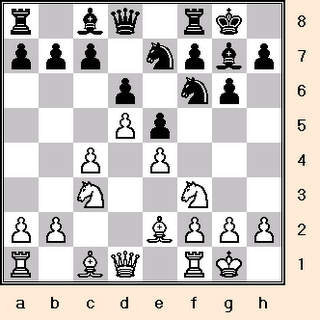
What's the game plan for White?

Instead of initiating queenside operations
through 9 b4 (Please refer to Understanding
the Classical King's Indian Part I), White can
opt for 9 Nd2. This move not only prepares
for b4, c5 and Nc4, but it also prevents
... Nh5, so, if Black wants to play ... f5,
he must move his knight backwards. 9 Ne1 is
also a viable alternative for White. It too
deters ... Nh5, but it abandons the plan to
relocate the knight to the best square c4,
aiming for d3 instead. From d3, the knight
supports b4 and c5.
What's the game plan for Black?

Mitigate White's queenside attack by
9 ... a5 or 9 ... c5. 9 ... a5 gains Black
a tempo because White is now compelled
to prepare b4 with the moves a3 and Rb1.
9 ... c5, on the other hand, easily permits
the Rb1 and b4 offensive, but, it prevents
White from attaining a significant space
advantage, thus forcing him to execute the
attack on a narrower front. Black can also
make a pre-emptive strike via ... c6 so as
to interfere with White's assault. Initiating
kingside action through 9 ... Ne8 or 9 ... Nd7
is inadvisable because White's attack arrives
first.
Also available:
Understanding the Classical King's Indian Part I
http://chesscoach1950.blogspot.com/2006/01/chess-understanding-classical-kings.html
Chess: Understanding the King's Indian Defense
(Four Pawns Attack)
http://chesscoach1950.blogspot.com/2006/07/chess-understanding-kings-indian.html
Chess: Understanding the King's Indian Defense
http://chesscoach1950.blogspot.com/2006/07/chess-understanding-kings-_115334967809416889.html
Chess: Understanding the King's Indian Defense
(g3 Systems)
http://chesscoach1950.blogspot.com/2006/08/chess-understanding-kings-indian.html
1 d4
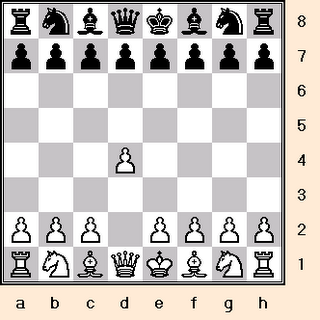
Opening up a diagonal for the c1 bishop and attacking
the e5 and c5 squares.
1 ... Nf6
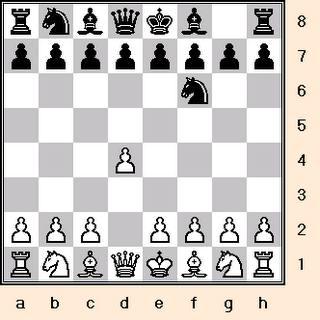
Developing the knight and also controlling the
squares d5 and e4.
2 c4
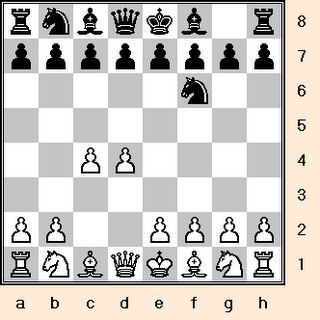
White challenges Black's claim to d5.
The d1-a4 diagonal also opens up for
the Queen.
2 ... g6
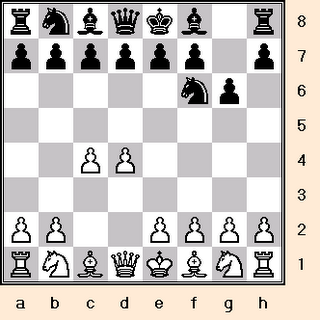
In preparation for placing the f8 bishop on g7,
where it will scope out the a1-h8 diagonal.
3 Nc3

Mobilization towards the center. Now the e4 square
is no longer under Black's sole control.
3 Nf3
3 g3
3 f3
3 d5
3 Bg5
3 Nd2
3 e3
3 b3
3 e4
3 Bf4
3 ... Bg7
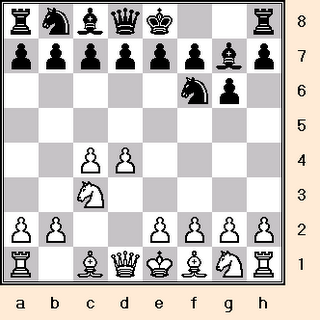
3 ... d5
3 ... d6
3 ... c5
3 ... c6
4 e4
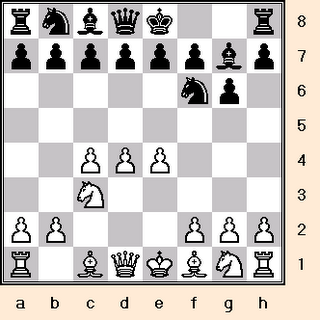
White opens up a diagonal for the Queen and f1 bishop.
He also attacks the d5 and f5 squares.
4 Nf3
4 g3
4 Bg5
4 Bf4
4 d5
4 e3
4 f4
4 f3
4 ... d6
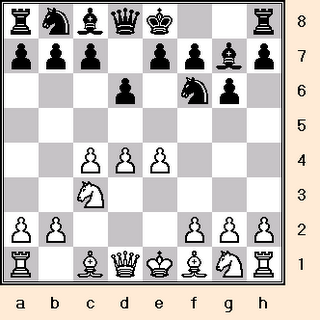
Preparing for ... e5 . Additionally, a diagonal
is opened up for the c8 bishop.
4 ... O-O
4 ... c5
5 Nf3
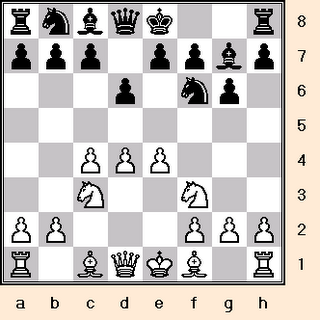
The central e5 square comes into the knight's
view and the d4 pawn gets another defender.
5 Be2
5 f3
5 h3
5 Bd3
5 Nge2
5 Bg5
5 g3
5 Be3
5 Bf4
5 f4 O-O 6 e5 Nfd7 7 Nf3 c5.
5 ... 0-0
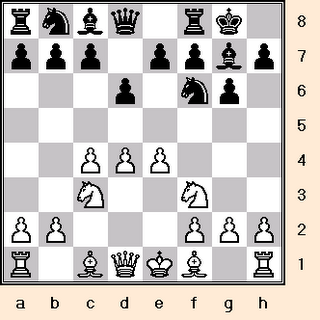
Assigning the King to a safe position and
activating the h8 rook.
5 ... c5
5 ... Bg4
5 ... Nbd7
5 ... e5
5 ... c6
5 ... Nc6
6 Be2
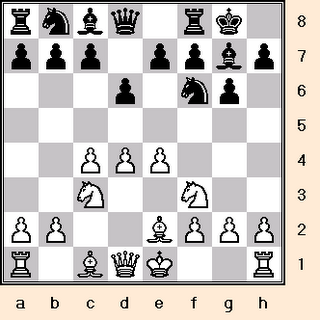
White prepares to castle.
6 h3
6 Be3
6 Bg5
6 g3
6 Bd3
6 Ne2
6 Ng5
6 ... e5

Staking a claim in the center. Also, by attacking d4,
the e5 pawn augments the latent pressure exerted on
that square by the g7 bishop. Note how the bishop
comes to life along the a1-h8 diagonal, once the
f6 knight is developed elsewhere.
6 ... Na6
6 ... Bg4
6 ... Nbd7
6 ... c5
6 ... c6
6 ... Nc6
6 ... a5
6 ... a6
6 ... Qe8
7 0-0

Completing kingside development.
7 d5
7 Bg5
7 h3
7 Qc2
7 dxe5 dxe5 8 Qxd8 Rxd8 9 Bg5 Re8
10 Nd5 Nxd5 11 cxd5 c6 12 Bc4 cxd5 13 Bxd5.
7 Be3 Ng4 8 Bg5 f6 9 Bh4 Nc6
10 d5 Ne7 11 Nd2 Nh6 12 f3 c6 13 dxc6 bxc6
14 b4 Be6 15 Nb3 d5 16 Nc5 Bf7 17 cxd5 cxd5
18 exd5 Nhf5 19 Bf2 Nxd5 20 Nxd5 Bxd5.
7 ... Nc6

The knight comes into the game and further pressures
the d4 pawn.
7 ... Nbd7
7 ... Na6
7 ... exd4
7 ... c6
7 ... Qe8
7 ... Nh5
7 ... a5
7 ... Qe7
7 ... Bg4
7 ... c5
8 d5

Evading the heat and attacking c6.
8 Be3
8 dxe5
8 b4
8 ... Ne7

8 ... Nb8 9 Bg5 a5 10 Nd2 Na6 11 a3 Bd7 12 Qc2 Qe8
13 Nb5 h5 14 Rae1 Nh7 15 Be3 h4 16 Kh1 b6.
By ChessCoach@care2.com
6 Be2 e5 7 0-0 Nc6 8 d5 Ne7 Line

What's the game plan for White?

Instead of initiating queenside operations
through 9 b4 (Please refer to Understanding
the Classical King's Indian Part I), White can
opt for 9 Nd2. This move not only prepares
for b4, c5 and Nc4, but it also prevents
... Nh5, so, if Black wants to play ... f5,
he must move his knight backwards. 9 Ne1 is
also a viable alternative for White. It too
deters ... Nh5, but it abandons the plan to
relocate the knight to the best square c4,
aiming for d3 instead. From d3, the knight
supports b4 and c5.
What's the game plan for Black?

Mitigate White's queenside attack by
9 ... a5 or 9 ... c5. 9 ... a5 gains Black
a tempo because White is now compelled
to prepare b4 with the moves a3 and Rb1.
9 ... c5, on the other hand, easily permits
the Rb1 and b4 offensive, but, it prevents
White from attaining a significant space
advantage, thus forcing him to execute the
attack on a narrower front. Black can also
make a pre-emptive strike via ... c6 so as
to interfere with White's assault. Initiating
kingside action through 9 ... Ne8 or 9 ... Nd7
is inadvisable because White's attack arrives
first.
Also available:
Understanding the Classical King's Indian Part I
http://chesscoach1950.blogspot.com/2006/01/chess-understanding-classical-kings.html
Chess: Understanding the King's Indian Defense
(Four Pawns Attack)
http://chesscoach1950.blogspot.com/2006/07/chess-understanding-kings-indian.html
Chess: Understanding the King's Indian Defense
http://chesscoach1950.blogspot.com/2006/07/chess-understanding-kings-_115334967809416889.html
Chess: Understanding the King's Indian Defense
(g3 Systems)
http://chesscoach1950.blogspot.com/2006/08/chess-understanding-kings-indian.html
1 d4

Opening up a diagonal for the c1 bishop and attacking
the e5 and c5 squares.
1 ... Nf6

Developing the knight and also controlling the
squares d5 and e4.
2 c4

White challenges Black's claim to d5.
The d1-a4 diagonal also opens up for
the Queen.
2 ... g6

In preparation for placing the f8 bishop on g7,
where it will scope out the a1-h8 diagonal.
3 Nc3

Mobilization towards the center. Now the e4 square
is no longer under Black's sole control.
3 Nf3
3 g3
3 f3
3 d5
3 Bg5
3 Nd2
3 e3
3 b3
3 e4
3 Bf4
3 ... Bg7

3 ... d5
3 ... d6
3 ... c5
3 ... c6
4 e4

White opens up a diagonal for the Queen and f1 bishop.
He also attacks the d5 and f5 squares.
4 Nf3
4 g3
4 Bg5
4 Bf4
4 d5
4 e3
4 f4
4 f3
4 ... d6

Preparing for ... e5 . Additionally, a diagonal
is opened up for the c8 bishop.
4 ... O-O
4 ... c5
5 Nf3

The central e5 square comes into the knight's
view and the d4 pawn gets another defender.
5 Be2
5 f3
5 h3
5 Bd3
5 Nge2
5 Bg5
5 g3
5 Be3
5 Bf4
5 f4 O-O 6 e5 Nfd7 7 Nf3 c5.
5 ... 0-0

Assigning the King to a safe position and
activating the h8 rook.
5 ... c5
5 ... Bg4
5 ... Nbd7
5 ... e5
5 ... c6
5 ... Nc6
6 Be2

White prepares to castle.
6 h3
6 Be3
6 Bg5
6 g3
6 Bd3
6 Ne2
6 Ng5
6 ... e5

Staking a claim in the center. Also, by attacking d4,
the e5 pawn augments the latent pressure exerted on
that square by the g7 bishop. Note how the bishop
comes to life along the a1-h8 diagonal, once the
f6 knight is developed elsewhere.
6 ... Na6
6 ... Bg4
6 ... Nbd7
6 ... c5
6 ... c6
6 ... Nc6
6 ... a5
6 ... a6
6 ... Qe8
7 0-0

Completing kingside development.
7 d5
7 Bg5
7 h3
7 Qc2
7 dxe5 dxe5 8 Qxd8 Rxd8 9 Bg5 Re8
10 Nd5 Nxd5 11 cxd5 c6 12 Bc4 cxd5 13 Bxd5.
7 Be3 Ng4 8 Bg5 f6 9 Bh4 Nc6
10 d5 Ne7 11 Nd2 Nh6 12 f3 c6 13 dxc6 bxc6
14 b4 Be6 15 Nb3 d5 16 Nc5 Bf7 17 cxd5 cxd5
18 exd5 Nhf5 19 Bf2 Nxd5 20 Nxd5 Bxd5.
7 ... Nc6

The knight comes into the game and further pressures
the d4 pawn.
7 ... Nbd7
7 ... Na6
7 ... exd4
7 ... c6
7 ... Qe8
7 ... Nh5
7 ... a5
7 ... Qe7
7 ... Bg4
7 ... c5
8 d5

Evading the heat and attacking c6.
8 Be3
8 dxe5
8 b4
8 ... Ne7

8 ... Nb8 9 Bg5 a5 10 Nd2 Na6 11 a3 Bd7 12 Qc2 Qe8
13 Nb5 h5 14 Rae1 Nh7 15 Be3 h4 16 Kh1 b6.
By ChessCoach@care2.com

0 Comments:
Post a Comment
<< Home